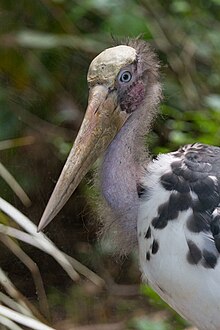Lesser adjutant
| Lesser Adjutant | |
|---|---|

| |
| Scientific classification | |
| Kingdom: | |
| Phylum: | |
| Class: | |
| Order: | |
| Family: | |
| Genus: | |
| Species: | L. javanicus
|
| Binomial name | |
| Leptoptilos javanicus Horsfield, 1821
| |
The Lesser Adjutant (Leptoptilos javanicus) is a large wading bird in the stork family Ciconiidae. Like other members of its genus, it has a bare neck and head. It is however more closely associated with wetland habitats where it is solitary and is less likely to scavenge than the related Greater Adjutant. It is a widespread species found from India through Southeast Asia to Java.
Description

A large stork with an upright stance, a bare head and neck without a pendant pounch, it has a length of 87–93 cm (34–37 in) (outstretched from bill-to-tail measurement), weigh from 4 to 5.71 kg (8.8 to 12.6 lb) and stands about 110–120 cm (43–47 in) tall.[2][3][4] The only confusable species is the Greater Adjutant, but this species is generally smaller and has a straight upper bill edge (culmen), measuring 25.8–30.8 cm (10.2–12.1 in) in length, with a paler base and appears slightly trimmer and less hunch-backed. The skullcap is paler and the upper plumage is uniformly dark, appearing almost all black. The nearly naked head and neck have a few scattered hair-like feathers. The upper shank or tibia is grey rather than pink, the tarsus measures 22.5–26.8 cm (8.9–10.6 in). The belly and undertail are white. Juveniles are a duller version of the adult but have more feathers on the nape.[5] During the breeding season, the face is reddish and the neck is orange. The larger median wing coverts are tipped with copper spots and the inner secondary coverts and tertials have narrow white edging. The wing chord measures 57.5–66 cm (22.6–26.0 in) in length. Like others in the genus, they retract their necks in flight. In flight, the folded neck can appear like the pouch of the Greater Adjutant.[6] Males and females appear similar in plumage but males tend to be larger and heavier billed.[4][7]
Distribution and habitat
The Lesser Adjutant tends to be widely dispersed and is very local. It is often found in large rivers and lakes inside well wooded regions. It is found in India, Nepal,[8] Sri Lanka, Bangladesh, Myanmar, Thailand, Vietnam, Malaysia, Laos, Singapore,[9] Indonesia and Cambodia. The largest population is in India in the eastern states of Assam, West Bengal and Bihar. It may occur as a vagrant on the southern edge of Bhutan.[10] They are extremely rare in southern India.[11][12]
Behaviour and ecology
The Lesser Adjutant stalks around wetlands feeding mainly on fish, frogs, reptiles and large invertebrates. They rarely feed on carrion. They may also take small birds and rodents particularly during the breeding season. They are solitary except during the breeding season when they form loose colonies.[2] The breeding season is February to May in southern India and November to January in northeastern India.[13] The nest is a large platform of sticks placed on a tall tree. The nest diameter is more than a metre and up to a metre deep.[2] The clutch consists of three to four eggs.[13][14] They are silent but have been noted to clatter their bill, hiss and moan at the nest.[6]
References
- ^ Template:IUCN
- ^ a b c Ali, S & SD Ripley (1978). Handbook of the Birds of India and Pakistan. Volume 1 (2 ed.). New Delhi: Oxford University Press. pp. 107–109.
- ^ Elliot, A. (1994). "Order Ciconiiformes. Family Ciconiidae (Storks)". In del Hoyo, J., A. Elliot & J. Sargatal (ed.). Handbook of the Birds of the World. Volume 1. Ostrich to Ducks. Barcelona, Spain: Lynx Edicions. pp. 436–465.
{{cite book}}: CS1 maint: multiple names: editors list (link) - ^ a b Hancock & Kushan, Storks, Ibises and Spoonbills of the World. Princeton University Press (1992), ISBN 978-0-12-322730-0
- ^ Blanford, WT (1898). The Fauna of British India. Birds. Volume 4. London: Taylor and Francis. pp. 374–375.
- ^ a b Rasmussen PC & JC Anderton (2005). Birds of South Asia. The Ripley Guide. Volume 2. Washington DC and Barcelona: Smithsonian Institution and Lynx Edicions. p. 64.
- ^ Weckauf R & M Handschuh (2011). "A method for identifying the sex of lesser adjutant storks Leptoptilos javanicus using digital photographs" (PDF). Cambodian Journal of Natural History (1): 23–28.
- ^ Baral HS (2005). "Surveys for Lesser Adjutant Leptoptilos javanicus in and around Koshi Tappu Wildlife Reserve, Nepal" (PDF). Forktail. 21: 190–193.
- ^ Subaraj R and A. F. S. L. Lok (2009). "Status of the Lesser Adjutant Stork (Leptoptilos javanicus)" (PDF). Nature in Singapore. 2: 107–113.
- ^ Choudhury, A. (2005). "First record of Lesser Adjutant Leptoptilos javanicus for Bhutan" (PDF). Forktail. 21: 164–165.
- ^ Andheria, A. P. (2001). J. Bombay Nat. Hist. Soc. 98 (3): 443–445.
{{cite journal}}: Missing or empty|title=(help) - ^ Andheria, A. (2003). "First sighting of lesser adjutant-stork Leptoptilos javanicus from Sanjay Gandhi National Park, Mumbai". J. Bombay Nat. Hist. Soc. 100 (1): 111.
- ^ a b Baker, ECS (1929). Fauna of British India. Birds. Volume 6 (2 ed.). London: Taylor and Francis. pp. 329–330.
- ^ Maust, M., Clum, N. and Sheppard, C. (2007). "Ontogeny of chick behavior: a tool for monitoring the growth and development of lesser adjutant storks". Zoo Biol. 26 (6): 533–538. doi:10.1002/zoo.20156. PMID 19360599.
{{cite journal}}: CS1 maint: multiple names: authors list (link)

